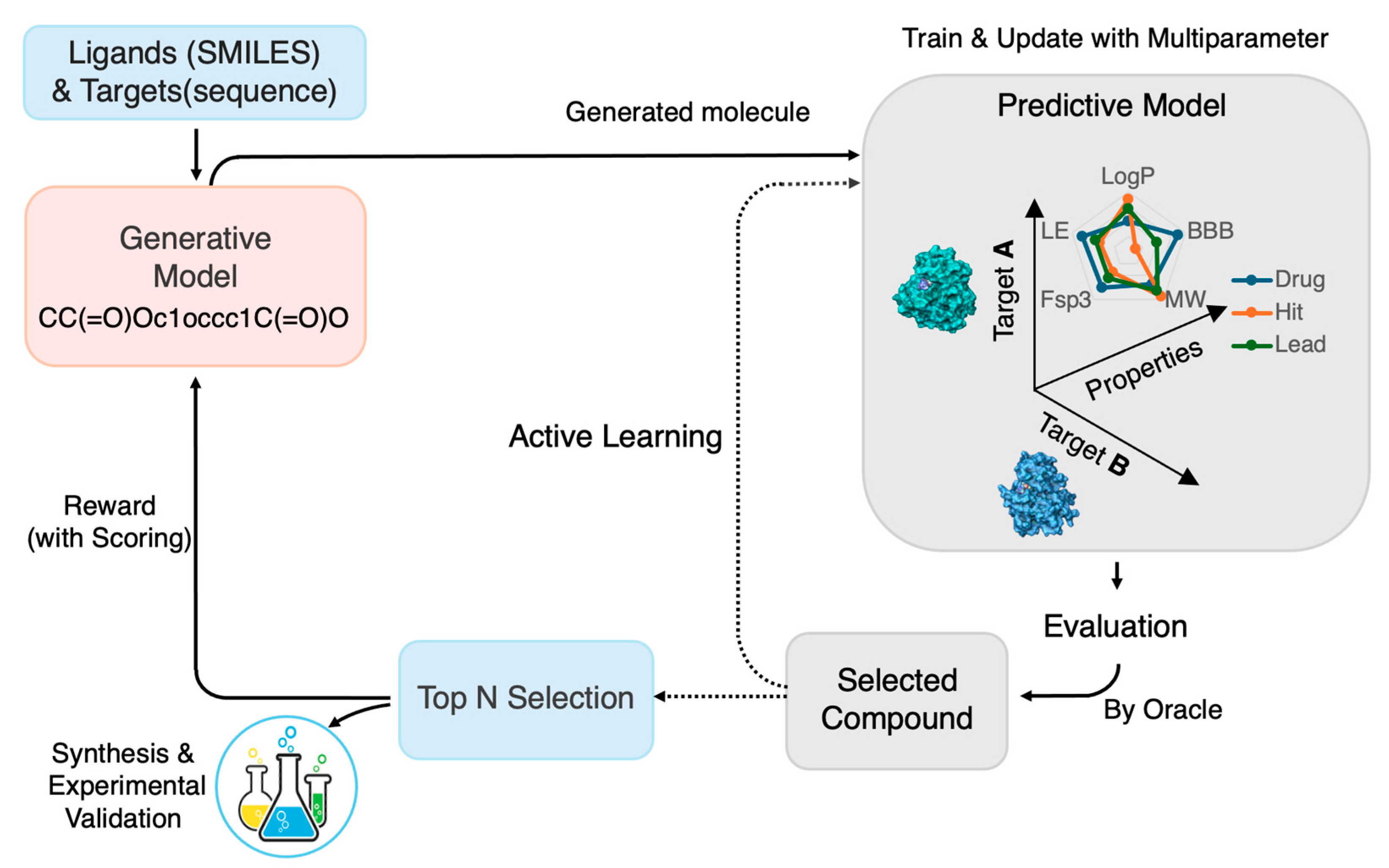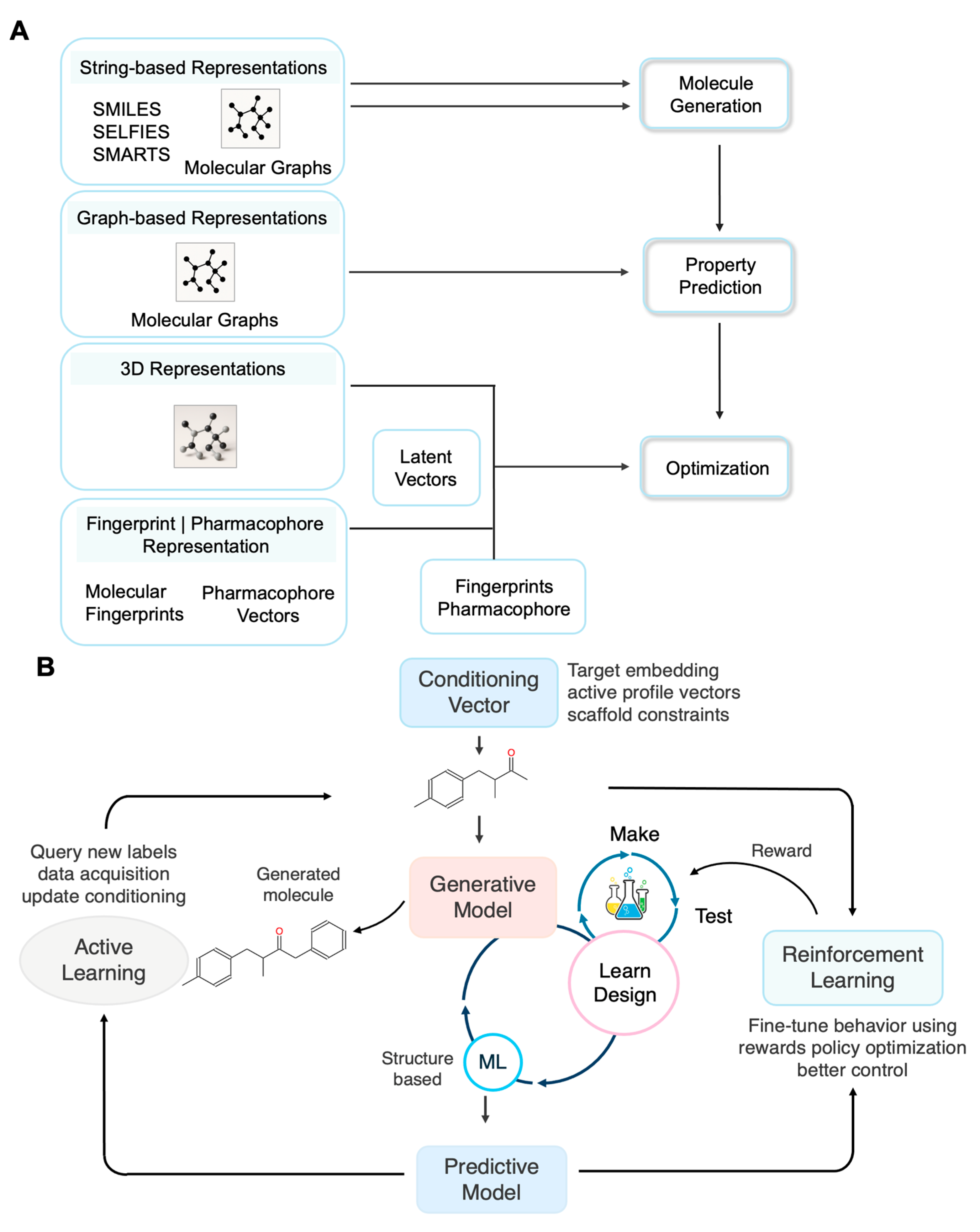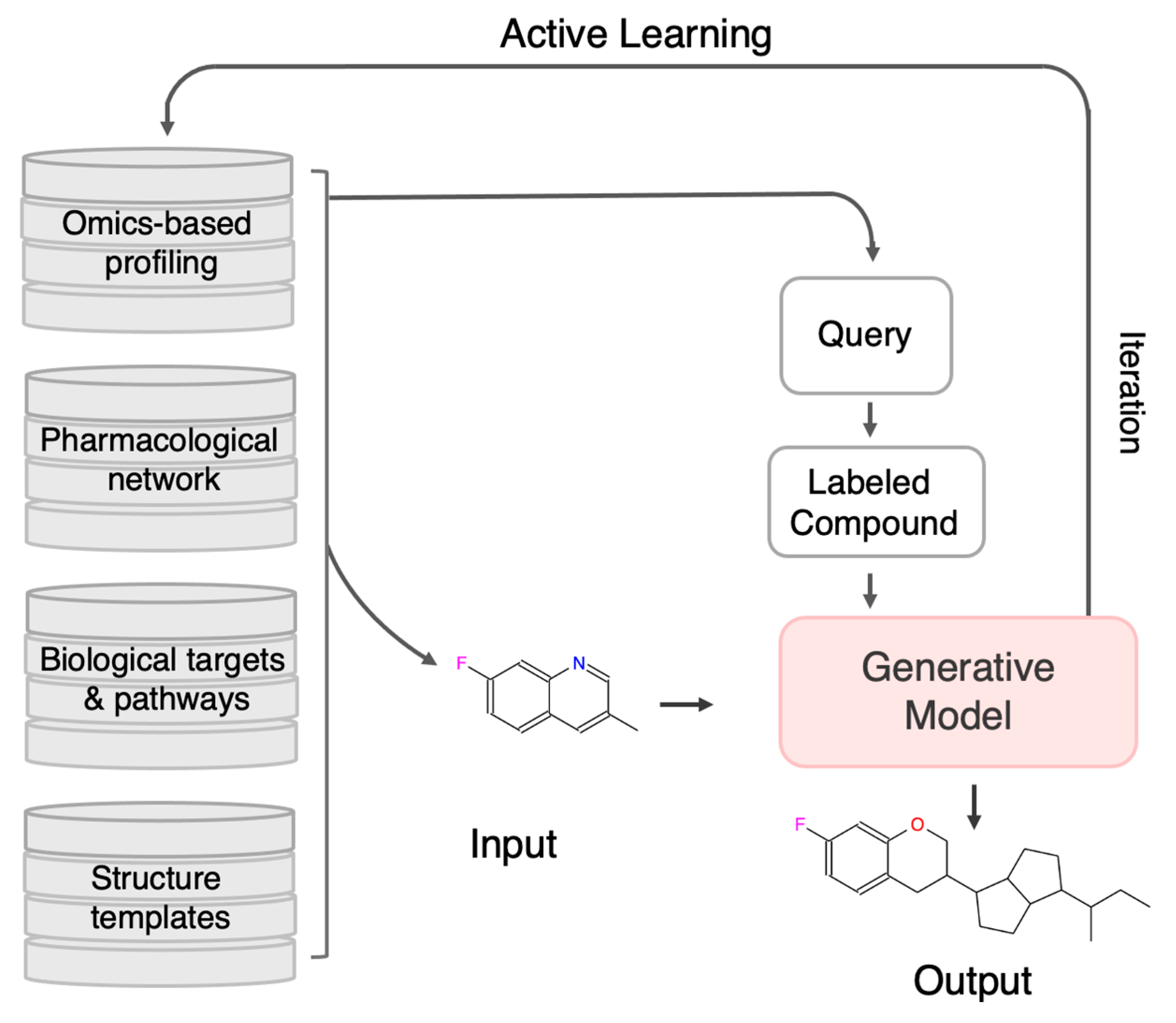Deep Generative AI for Multi-Target Therapeutic Design: Toward Self-Improving Drug Discovery Framework
Abstract
1. Introduction
2. Evolution of Drug Discovery Paradigms
3. Deep Generative Models in Molecular Design
3.1. Molecular Representations
3.2. Deep Generative Model Architectures
3.3. Comparative Analysis of Deep Generative Model Architectures
3.4. Goal-Directed Generation and Guided Optimization
4. Self-Improving Systems in AI-Driven Drug Design
4.1. The Principle of Self-Improvement
4.2. The Design-Make-Test-Learn (DMTL) Loop
4.3. Self-Improving Algorithms for Optimizing Drug Design
5. Applications and Case Studies
5.1. Applications in Multi-Target Cancer Therapeutics
5.2. Benchmarking and Validation
5.3. Modern Approaches for Structure-Based Multi-Target Drug Design
5.4. Approaches to Ligand-Based Multi-Target Drug Discovery
6. Challenges and Limitations in AI-Driven Drug Design
7. Conclusions and Future Prospects
Author Contributions
Funding
Institutional Review Board Statement
Informed Consent Statement
Data Availability Statement
Conflicts of Interest
References
- Savage, N. Tapping into the Drug Discovery Potential of AI. Biopharm. Deal. 2021, B37–B39. [Google Scholar] [CrossRef]
- Topol, E.J. High-Performance Medicine: The Convergence of Human and Artificial Intelligence. Nat. Med. 2019, 25, 44–56. [Google Scholar] [CrossRef]
- Chen, W.; Liu, X.; Zhang, S.; Chen, S. Artificial Intelligence for Drug Discovery: Resources, Methods, and Applications. Mol. Ther.-Nucleic Acids 2023, 31, 691–702. [Google Scholar] [CrossRef] [PubMed]
- Zeng, X.; Wang, F.; Luo, Y.; Kang, S.; Tang, J.; Lightstone, F.C.; Fang, E.F.; Cornell, W.; Nussinov, R.; Cheng, F. Deep Generative Molecular Design Reshapes Drug Discovery. Cell Rep. Med. 2022, 3, 100794. [Google Scholar] [CrossRef] [PubMed]
- Schneider, P.; Walters, W.P.; Plowright, A.T.; Sieroka, N.; Listgarten, J.; Goodnow, R.A.; Fisher, J.; Jansen, J.M.; Duca, J.S.; Rush, T.S.; et al. Rethinking Drug Design in the Artificial Intelligence Era. Nat. Rev. Drug Discov. 2020, 19, 353–364. [Google Scholar] [CrossRef]
- Paul, D.; Sanap, G.; Shenoy, S.; Kalyane, D.; Kalia, K.; Tekade, R.K. Artificial Intelligence in Drug Discovery and Development. Drug Discov. Today 2021, 26, 80–93. [Google Scholar] [CrossRef]
- Kuenzi, B.M.; Park, J.; Fong, S.H.; Sanchez, K.S.; Lee, J.; Kreisberg, J.F.; Ma, J.; Ideker, T. Predicting Drug Response and Synergy Using a Deep Learning Model of Human Cancer Cells. Cancer Cell 2020, 38, 672–684.e6. [Google Scholar] [CrossRef]
- You, Y.; Lai, X.; Pan, Y.; Zheng, H.; Vera, J.; Liu, S.; Deng, S.; Zhang, L. Artificial Intelligence in Cancer Target Identification and Drug Discovery. Signal Transduct. Target. Ther. 2022, 7, 156. [Google Scholar] [CrossRef]
- Pandey, D.R.; Dash, S.S.; Mishra, A. Advances of AI-Driven Drug Design and Discovery in Pharmaceuticals—Review. J. Angiother. 2024, 8, 1–10. [Google Scholar] [CrossRef]
- Zhang, W.; Pei, J.; Lai, L. Computational Multitarget Drug Design. J. Chem. Inf. Model. 2017, 57, 403–412. [Google Scholar] [CrossRef]
- Zhou, Y.; Wang, F.; Tang, J.; Nussinov, R.; Cheng, F. Artificial Intelligence in COVID-19 Drug Repurposing. Lancet Digit. Health 2020, 2, e667–e676. [Google Scholar] [CrossRef]
- Fillinger, L.; Walter, S.; Ley, M.; Kęska-Izworska, K.; Dehkordi, L.G.; Kratochwill, K.; Perco, P. Computational Modeling Approaches and Regulatory Pathways for Drug Combinations. Drug Discov. Today 2025, 30, 104345. [Google Scholar] [CrossRef]
- Yang, K.; Zang, C.; Wang, F. Visualizing Deep Graph Generative Models for Drug Discovery. arXiv 2020, arXiv:2007.10333. [Google Scholar] [CrossRef]
- Gómez-Bombarelli, R.; Wei, J.N.; Duvenaud, D.; Hernández-Lobato, J.M.; Sánchez-Lengeling, B.; Sheberla, D.; Aguilera-Iparraguirre, J.; Hirzel, T.D.; Adams, R.P.; Aspuru-Guzik, A. Automatic Chemical Design Using a Data-Driven Continuous Representation of Molecules. ACS Cent. Sci. 2018, 4, 268–276. [Google Scholar] [CrossRef]
- Sanchez-Lengeling, B.; Aspuru-Guzik, A. Inverse Molecular Design Using Machine Learning: Generative Models for Matter Engineering. Science 2018, 361, 360–365. [Google Scholar] [CrossRef] [PubMed]
- Csermely, P.; Korcsmáros, T.; Kiss, H.J.M.; London, G.; Nussinov, R. Structure and Dynamics of Molecular Networks: A Novel Paradigm of Drug Discovery. Pharmacol. Ther. 2013, 138, 333–408. [Google Scholar] [CrossRef]
- Sousa, T.; Correia, J.; Pereira, V.; Rocha, M. Generative Deep Learning for Targeted Compound Design. J. Chem. Inf. Model. 2021, 61, 5343–5361. [Google Scholar] [CrossRef] [PubMed]
- Krenn, M.; Häse, F.; Nigam, A.; Friederich, P.; Aspuru-Guzik, A. Self-Referencing Embedded Strings (SELFIES): A 100% Robust Molecular String Representation. Mach. Learn. Sci. Technol. 2020, 1, 045024. [Google Scholar] [CrossRef]
- Zhang, Z.; Yang, C.; Qin, Y.; Zheng, Z.; Feng, J.; Li, H. Addressing High-Performance Data Sparsity in Metasurface Inverse Design Using Multi-Objective Optimization and Diffusion Probabilistic Models. Opt. Express 2024, 32, 40869. [Google Scholar] [CrossRef] [PubMed]
- Atance, S.R.; Diez, J.V.; Engkvist, O.; Olsson, S.; Mercado, R. De Novo Drug Design Using Reinforcement Learning with Graph-Based Deep Generative Models. J. Chem. Inf. Model. 2022, 62, 4863–4872. [Google Scholar] [CrossRef]
- Li, C.; Gao, X.; Li, Y.; Peng, B.; Li, X.; Zhang, Y.; Gao, J. Optimus: Organizing Sentences via Pre-Trained Modeling of a Latent Space. arXiv 2020, arXiv:2004.04092. [Google Scholar] [CrossRef]
- Yang, L.; Yang, G.; Bing, Z.; Tian, Y.; Niu, Y.; Huang, L.; Yang, L. Transformer-Based Generative Model Accelerating the Development of Novel BRAF Inhibitors. ACS Omega 2021, 6, 33864–33873. [Google Scholar] [CrossRef]
- Morehead, A.; Cheng, J. Geometry-Complete Diffusion for 3D Molecule Generation and Optimization. Commun. Chem. 2024, 7, 150. [Google Scholar] [CrossRef] [PubMed]
- Blaschke, T.; Bajorath, J. Fine-Tuning of a Generative Neural Network for Designing Multi-Target Compounds. J. Comput. Aided Mol. Des. 2022, 36, 363–371. [Google Scholar] [CrossRef] [PubMed]
- Abramson, J.; Adler, J.; Dunger, J.; Evans, R.; Green, T.; Pritzel, A.; Ronneberger, O.; Willmore, L.; Ballard, A.J.; Bambrick, J.; et al. Accurate Structure Prediction of Biomolecular Interactions with AlphaFold 3. Nature 2024, 630, 493–500. [Google Scholar] [CrossRef]
- Munson, B.P.; Chen, M.; Bogosian, A.; Kreisberg, J.F.; Licon, K.; Abagyan, R.; Kuenzi, B.M.; Ideker, T. De Novo Generation of Multi-Target Compounds Using Deep Generative Chemistry. Nat. Commun. 2024, 15, 3636. [Google Scholar] [CrossRef]
- Chen, Y.; Wang, Z.; Wang, L.; Wang, J.; Li, P.; Cao, D.; Zeng, X.; Ye, X.; Sakurai, T. Deep Generative Model for Drug Design from Protein Target Sequence. J. Cheminform. 2023, 15, 38. [Google Scholar] [CrossRef]
- Chen, H.; Bajorath, J. Generative Design of Compounds with Desired Potency from Target Protein Sequences Using a Multimodal Biochemical Language Model. J. Cheminform. 2024, 16, 55. [Google Scholar] [CrossRef] [PubMed]
- Cerveira, A.; Kremer, F.; de Andrade Lourenço, D.; Corrêa, U.B. Evaluation Framework for AI-Driven Molecular Design of Multi-Target Drugs: Brain Diseases as a Case Study. arXiv 2024, arXiv:2408.10482. [Google Scholar] [CrossRef]
- Moreira-Filho, J.T.; Da Silva, M.F.B.; Borba, J.V.V.B.; Filho, A.R.G.; Muratov, E.N.; Andrade, C.H.; Braga, R.D.C.; Neves, B.J. Artificial Intelligence Systems for the Design of Magic Shotgun Drugs. Artif. Intell. Life Sci. 2023, 3, 100055. [Google Scholar] [CrossRef]
- Langevin, M.; Minoux, H.; Levesque, M.; Bianciotto, M. Scaffold-Constrained Molecular Generation. J. Chem. Inf. Model. 2020, 60, 5637–5646. [Google Scholar] [CrossRef]
- Arús-Pous, J.; Patronov, A.; Bjerrum, E.J.; Tyrchan, C.; Reymond, J.-L.; Chen, H.; Engkvist, O. SMILES-Based Deep Generative Scaffold Decorator for de-Novo Drug Design. J. Cheminform. 2020, 12, 38. [Google Scholar] [CrossRef] [PubMed]
- Xu, T.; Wang, M.; Liu, X.; Feng, D.; Zhu, Y.; Fan, Z.; Rao, S.; Lu, J. A Scaffold-based Deep Generative Model Considering Molecular Stereochemical Information. Mol. Inform. 2022, 41, 2200088. [Google Scholar] [CrossRef]
- Popova, M.; Isayev, O.; Tropsha, A. Deep Reinforcement Learning for de Novo Drug Design. Sci. Adv. 2018, 4, eaap7885. [Google Scholar] [CrossRef]
- Kosaraju, D. Self-Improving Algorithms: How Autonomous AI Is Shaping the Next Generation of Intelligent Systems. Int. J. Sci. Healthc. Res. 2024, 8, 323–329. [Google Scholar] [CrossRef]
- Van Lent, P.; Schmitz, J.; Abeel, T. Simulated Design–Build–Test–Learn Cycles for Consistent Comparison of Machine Learning Methods in Metabolic Engineering. ACS Synth. Biol. 2023, 12, 2588–2599. [Google Scholar] [CrossRef] [PubMed]
- Smith, J.S.; Nebgen, B.; Lubbers, N.; Isayev, O.; Roitberg, A.E. Less Is More: Sampling Chemical Space with Active Learning. J. Chem. Phys. 2018, 148, 241733. [Google Scholar] [CrossRef]
- Yin, T.; Panapitiya, G.; Coda, E.D.; Saldanha, E.G. Evaluating Uncertainty-Based Active Learning for Accelerating the Generalization of Molecular Property Prediction. J. Cheminform. 2023, 15, 105. [Google Scholar] [CrossRef]
- Nahal, Y.; Menke, J.; Martinelli, J.; Heinonen, M.; Kabeshov, M.; Janet, J.P.; Nittinger, E.; Engkvist, O.; Kaski, S. Human-in-the-Loop Active Learning for Goal-Oriented Molecule Generation. J. Cheminform. 2024, 16, 138. [Google Scholar] [CrossRef]
- Ertl, P.; Schuffenhauer, A. Estimation of Synthetic Accessibility Score of Drug-like Molecules Based on Molecular Complexity and Fragment Contributions. J. Cheminform. 2009, 1, 8. [Google Scholar] [CrossRef]
- Coley, C.W.; Rogers, L.; Green, W.H.; Jensen, K.F. SCScore: Synthetic Complexity Learned from a Reaction Corpus. J. Chem. Inf. Model. 2018, 58, 252–261. [Google Scholar] [CrossRef] [PubMed]
- Wang, S.; Wang, L.; Li, F.; Bai, F. DeepSA: A Deep-Learning Driven Predictor of Compound Synthesis Accessibility. J. Cheminform. 2023, 15, 103. [Google Scholar] [CrossRef]
- Kyro, G.W.; Martin, M.T.; Watt, E.D.; Batista, V.S. CardioGenAI: A Machine Learning-Based Framework for Re-Engineering Drugs for Reduced hERG Liability. J. Cheminform. 2025, 17, 30. [Google Scholar] [CrossRef]
- Ravikumar, B.; Aittokallio, T. Improving the Efficacy-Safety Balance of Polypharmacology in Multi-Target Drug Discovery. Expert Opin. Drug Discov. 2018, 13, 179–192. [Google Scholar] [CrossRef]
- Gagic, Z.; Ruzic, D.; Djokovic, N.; Djikic, T.; Nikolic, K. In Silico Methods for Design of Kinase Inhibitors as Anticancer Drugs. Front. Chem. 2020, 7, 873. [Google Scholar] [CrossRef] [PubMed]
- Singha, M.; Pu, L.; Srivastava, G.; Ni, X.; Stanfield, B.A.; Uche, I.K.; Rider, P.J.F.; Kousoulas, K.G.; Ramanujam, J.; Brylinski, M. Unlocking the Potential of Kinase Targets in Cancer: Insights from CancerOmicsNet, an AI-Driven Approach to Drug Response Prediction in Cancer. Cancers 2023, 15, 4050. [Google Scholar] [CrossRef] [PubMed]
- Yoshizawa, T.; Ishida, S.; Sato, T.; Ohta, M.; Honma, T.; Terayama, K. Selective Inhibitor Design for Kinase Homologs Using Multiobjective Monte Carlo Tree Search. J. Chem. Inf. Model. 2022, 62, 5351–5360. [Google Scholar] [CrossRef]
- Lelliott, E.J.; Sheppard, K.E.; McArthur, G.A. Harnessing the Immunotherapeutic Potential of CDK4/6 Inhibitors in Melanoma: Is Timing Everything? npj Precis. Onc. 2022, 6, 26. [Google Scholar] [CrossRef]
- Kleandrova, V.V.; Scotti, M.T.; Scotti, L.; Speck-Planche, A. Multi-Target Drug Discovery via PTML Modeling: Applications to the Design of Virtual Dual Inhibitors of CDK4 and HER2. Curr. Top. Med. Chem. 2021, 21, 661–675. [Google Scholar] [CrossRef]
- Wu, X.; Xu, Y.; Liang, Q.; Yang, X.; Huang, J.; Wang, J.; Zhang, H.; Shi, J. Recent Advances in Dual PI3K/mTOR Inhibitors for Tumour Treatment. Front. Pharmacol. 2022, 13, 875372. [Google Scholar] [CrossRef]
- Chow, L.Q.M.; Eckhardt, S.G. Sunitinib: From Rational Design to Clinical Efficacy. J. Clin. Oncol. 2007, 25, 884–896. [Google Scholar] [CrossRef]
- Gackowski, M.; Szewczyk-Golec, K.; Mądra-Gackowska, K.; Pluskota, R.; Koba, M. Quantitative Structure–Activity Relationship Analysis of Isosteviol-Related Compounds as Activated Coagulation Factor X (FXa) Inhibitors. Nutrients 2022, 14, 3521. [Google Scholar] [CrossRef]
- Parca, L.; Pepe, G.; Pietrosanto, M.; Galvan, G.; Galli, L.; Palmeri, A.; Sciandrone, M.; Ferrè, F.; Ausiello, G.; Helmer-Citterich, M. Modeling Cancer Drug Response through Drug-Specific Informative Genes. Sci. Rep. 2019, 9, 15222. [Google Scholar] [CrossRef] [PubMed]
- Jin, X.; Mei, Y.; Yang, P.; Huang, R.; Zhang, H.; Wu, Y.; Wang, M.; He, X.; Jiang, Z.; Zhu, W.; et al. Prioritization of Therapeutic Targets for Cancers Using Integrative Multi-Omics Analysis. Hum. Genom. 2024, 18, 42. [Google Scholar] [CrossRef] [PubMed]
- Deng, E.Z.; Marino, G.B.; Clarke, D.J.B.; Diamant, I.; Resnick, A.C.; Ma, W.; Wang, P.; Ma’ayan, A. Multiomics2Targets Identifies Targets from Cancer Cohorts Profiled with Transcriptomics, Proteomics, and Phosphoproteomics. Cell Rep. Methods 2024, 4, 100839. [Google Scholar] [CrossRef] [PubMed]
- Acosta-Vélez, G.; Linsley, C.; Craig, M.; Wu, B. Photocurable Bioink for the Inkjet 3D Pharming of Hydrophilic Drugs. Bioengineering 2017, 4, 11. [Google Scholar] [CrossRef]
- Acosta-Vélez, G.F.; Zhu, T.Z.; Linsley, C.S.; Wu, B.M. Photocurable Poly(Ethylene Glycol) as a Bioink for the Inkjet 3D Pharming of Hydrophobic Drugs. Int. J. Pharm. 2018, 546, 145–153. [Google Scholar] [CrossRef]
- Dong, Y.; Chang, Y.; Wang, Y.; Han, Q.; Wen, X.; Yang, Z.; Zhang, Y.; Qiang, Y.; Wu, K.; Fan, X.; et al. MFSynDCP: Multi-Source Feature Collaborative Interactive Learning for Drug Combination Synergy Prediction. BMC Bioinform. 2024, 25, 140. [Google Scholar] [CrossRef]
- Torkamannia, A.; Omidi, Y.; Ferdousi, R. SYNDEEP: A Deep Learning Approach for the Prediction of Cancer Drugs Synergy. Sci. Rep. 2023, 13, 6184. [Google Scholar] [CrossRef]
- Kadan, A.; Ryczko, K.; Lloyd, E.; Roitberg, A.; Yamazaki, T. Guided Multi-Objective Generative AI to Enhance Structure-Based Drug Design. Chem. Sci. 2025, 16, 13196–13210. [Google Scholar] [CrossRef]
- Isigkeit, L.; Hörmann, T.; Schallmayer, E.; Scholz, K.; Lillich, F.F.; Ehrler, J.H.M.; Hufnagel, B.; Büchner, J.; Marschner, J.A.; Pabel, J.; et al. Automated Design of Multi-Target Ligands by Generative Deep Learning. Nat. Commun. 2024, 15, 7946. [Google Scholar] [CrossRef]
- Peng, X.; Luo, S.; Guan, J.; Xie, Q.; Peng, J.; Ma, J. Pocket2Mol: Efficient Molecular Sampling Based on 3D Protein Pockets. Proc. Mach. Learn. Res. 2022, 162, 17644–17655. [Google Scholar]
- Schneuing, A.; Harris, C.; Du, Y.; Didi, K.; Jamasb, A.; Igashov, I.; Du, W.; Gomes, C.; Blundell, T.L.; Lio, P.; et al. Structure-Based Drug Design with Equivariant Diffusion Models. Nat. Comput. Sci. 2024, 4, 899–909. [Google Scholar] [CrossRef]
- Krishna, R.; Wang, J.; Ahern, W.; Sturmfels, P.; Venkatesh, P.; Kalvet, I.; Lee, G.R.; Morey-Burrows, F.S.; Anishchenko, I.; Humphreys, I.R.; et al. Generalized Biomolecular Modeling and Design with RoseTTAFold All-Atom. Science 2024, 384, eadl2528. [Google Scholar] [CrossRef]
- Kleandrova, V.V.; Cordeiro, M.N.D.S.; Speck-Planche, A. Ligand-Based Approach for Multi-Target Drug Discovery: PTML Modeling of Triple-Target Inhibitors. Curr. Top. Med. Chem. 2025, 25, 2179–2195. [Google Scholar] [CrossRef]
- Mendes, G.O.; Araújo Neto, M.F.D.; Barbosa, D.B.; Bomfim, M.R.D.; Andrade, L.S.M.; Carvalho, P.B.D.; Oliveira, T.A.D.; Falkoski, D.L.; Maia, E.H.B.; Valle, M.S.; et al. Identification of Potential Multitarget Compounds against Alzheimer’s Disease through Pharmacophore-Based Virtual Screening. Pharmaceuticals 2023, 16, 1645. [Google Scholar] [CrossRef]
- Zhu, H.; Zhou, R.; Cao, D.; Tang, J.; Li, M. A Pharmacophore-Guided Deep Learning Approach for Bioactive Molecular Generation. Nat. Commun. 2023, 14, 6234. [Google Scholar] [CrossRef] [PubMed]
- Shah, P.M.; Zhu, H.; Lu, Z.; Wang, K.; Tang, J.; Li, M. DeepDTAGen: A Multitask Deep Learning Framework for Drug-Target Affinity Prediction and Target-Aware Drugs Generation. Nat. Commun. 2025, 16, 5021. [Google Scholar] [CrossRef] [PubMed]
- Arabi, A.A. Artificial Intelligence in Drug Design: Algorithms, Applications, Challenges and Ethics. Future Drug. Discov. 2021, 3, FDD59. [Google Scholar] [CrossRef]
- Tu, Z.; Choure, S.J.; Fong, M.H.; Roh, J.; Levin, I.; Yu, K.; Joung, J.F.; Morgan, N.; Li, S.-C.; Sun, X.; et al. ASKCOS: An Open Source Software Suite for Synthesis Planning. arXiv 2025, arXiv:2501.01835. [Google Scholar] [CrossRef]
- Genheden, S.; Thakkar, A.; Chadimová, V.; Reymond, J.-L.; Engkvist, O.; Bjerrum, E. AiZynthFinder: A Fast, Robust and Flexible Open-Source Software for Retrosynthetic Planning. J. Cheminform. 2020, 12, 70. [Google Scholar] [CrossRef] [PubMed]




| Method | Protein Input | Ligand Input | Highlights | Usage |
|---|---|---|---|---|
| AlphaFold 3 | Sequence | SMILES | End-to-end protein-ligand modeling; multimodal | Protein-ligand complex generation |
| RFAA | Sequence + ligand | Optional ligand | Ligand-aware folding; end-to-end structure refinement | Protein-ligand complex generation |
| Pocket2Mol | 3D pocket (point cloud) | 3D ligand | Direct 3D ligand generation from protein pocket | Target-aware ligand structure generation |
| DiffSBDD | 3D pocket | 3D ligand | Samples ligand-pocket pairs from learned 3D distributions | Target-aware ligand structure generation |
| IDOLpro | Sequence | SMILES | Inverse design for ligand generation targeting proteins; sequence-to-molecule generation | Multi-target-based ligand structure generation |
| POLYGON | 2 protein targets (IDs) | SMILES | Polypharmacology-focused with dual-target optimization loop | Multi-target-based ligand structure generation |
| CLM | 2 protein targets (ligand sets) | SMILES | Fine-tuning with dual ligand templates; pharmacophore fusion | Multi-target-based ligand structure generation |
Disclaimer/Publisher’s Note: The statements, opinions and data contained in all publications are solely those of the individual author(s) and contributor(s) and not of MDPI and/or the editor(s). MDPI and/or the editor(s) disclaim responsibility for any injury to people or property resulting from any ideas, methods, instructions or products referred to in the content. |
© 2025 by the authors. Licensee MDPI, Basel, Switzerland. This article is an open access article distributed under the terms and conditions of the Creative Commons Attribution (CC BY) license (https://creativecommons.org/licenses/by/4.0/).
Share and Cite
Kang, S.I.; Shin, J.H.; Wu, B.M.; Choi, H.S. Deep Generative AI for Multi-Target Therapeutic Design: Toward Self-Improving Drug Discovery Framework. Int. J. Mol. Sci. 2025, 26, 11443. https://doi.org/10.3390/ijms262311443
Kang SI, Shin JH, Wu BM, Choi HS. Deep Generative AI for Multi-Target Therapeutic Design: Toward Self-Improving Drug Discovery Framework. International Journal of Molecular Sciences. 2025; 26(23):11443. https://doi.org/10.3390/ijms262311443
Chicago/Turabian StyleKang, Soo Im, Jae Hong Shin, Benjamin M. Wu, and Hak Soo Choi. 2025. "Deep Generative AI for Multi-Target Therapeutic Design: Toward Self-Improving Drug Discovery Framework" International Journal of Molecular Sciences 26, no. 23: 11443. https://doi.org/10.3390/ijms262311443
APA StyleKang, S. I., Shin, J. H., Wu, B. M., & Choi, H. S. (2025). Deep Generative AI for Multi-Target Therapeutic Design: Toward Self-Improving Drug Discovery Framework. International Journal of Molecular Sciences, 26(23), 11443. https://doi.org/10.3390/ijms262311443







